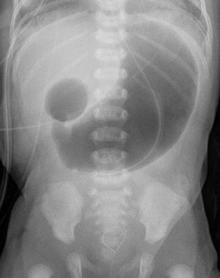
In radiology, the double bubble sign is a feature of pediatric imaging seen on radiographs or prenatal ultrasound in which two air filled bubbles are seen in the abdomen, representing two discontiguous loops of bowel in a proximal, or 'high,' small bowel obstruction. The finding is typically pathologic, and implies either duodenal atresia, duodenal web, annular pancreas, or on occasion midgut volvulus, a distinction that requires close clinical correlation and, in most cases, surgical intervention.[1][2][3]
Distal gas is more often seen with midgut volvulus, duodenal stenosis and duodenal web, though this not always present. In such cases, distinguishing the diagnoses depends on clinical presentation.[4]
- ^ Taylor, W. M. (1963). "The double bubble". The New Physician. 12: 277–8. PMID 13980384.
- ^ Chapman, S (1991). "The double bubble". British Journal of Hospital Medicine. 46 (5): 337–8. PMID 1958936.
- ^ Bezerra, J. A.; Duncan, B; Anderson, F (1992). "A one-month-old infant who had a 'double bubble'". Hospital Practice (Office Ed.). 27 (4): 255, 257–8. doi:10.1080/21548331.1992.11705409. PMID 1560073.
- ^ Esposito, Cara (2008-11-14). Pediatric Surgical Diseases: A Radiologic Surgical Case Study Approach. ISBN 9783540715160.